TOUR 471: Analysis of HR Challenges in the Tourism Industry
VerifiedAdded on 2022/11/19
|11
|2725
|2
Report
AI Summary
This report examines the human resource challenges impacting the tourism industry, focusing on labor shortages and strategies to mitigate them. The analysis covers various factors, including economic conditions, workforce diversity, technological advancements, government policies, environmental and seasonal factors, and the effects of globalization. The report identifies challenges such as poor pay, employee dissatisfaction, technological skill gaps, and the impact of seasonal employment. It further explores strategies for addressing these issues, advocating for a collaborative workplace culture, effective training programs, enhanced employee safety, and improved job satisfaction through benefits and flexible organizational structures. The report emphasizes the importance of human capital development and effective performance management in retaining skilled employees and ensuring the continued growth of the tourism sector.
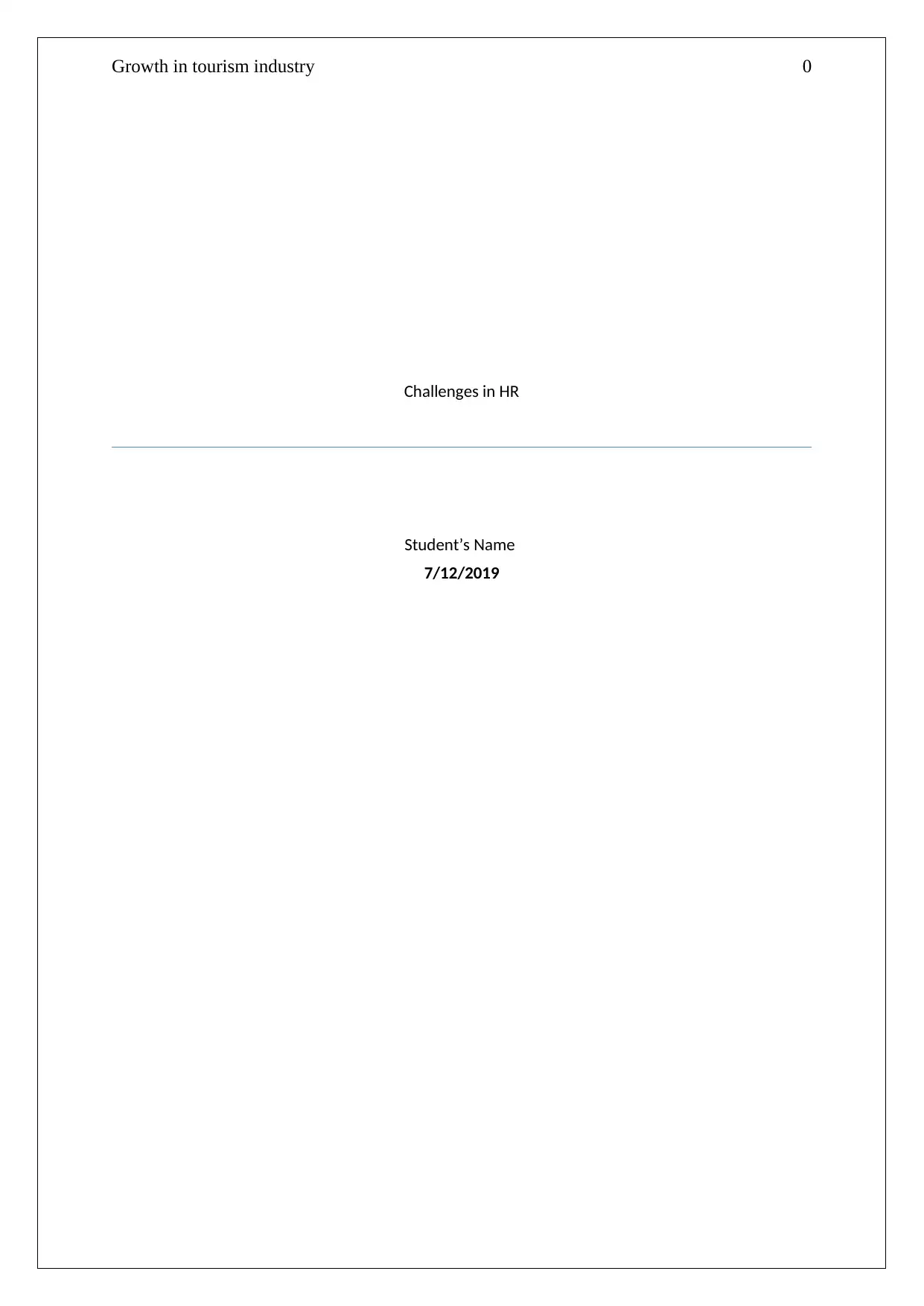
Growth in tourism industry 0
Challenges in HR
Student’s Name
7/12/2019
Challenges in HR
Student’s Name
7/12/2019
Paraphrase This Document
Need a fresh take? Get an instant paraphrase of this document with our AI Paraphraser
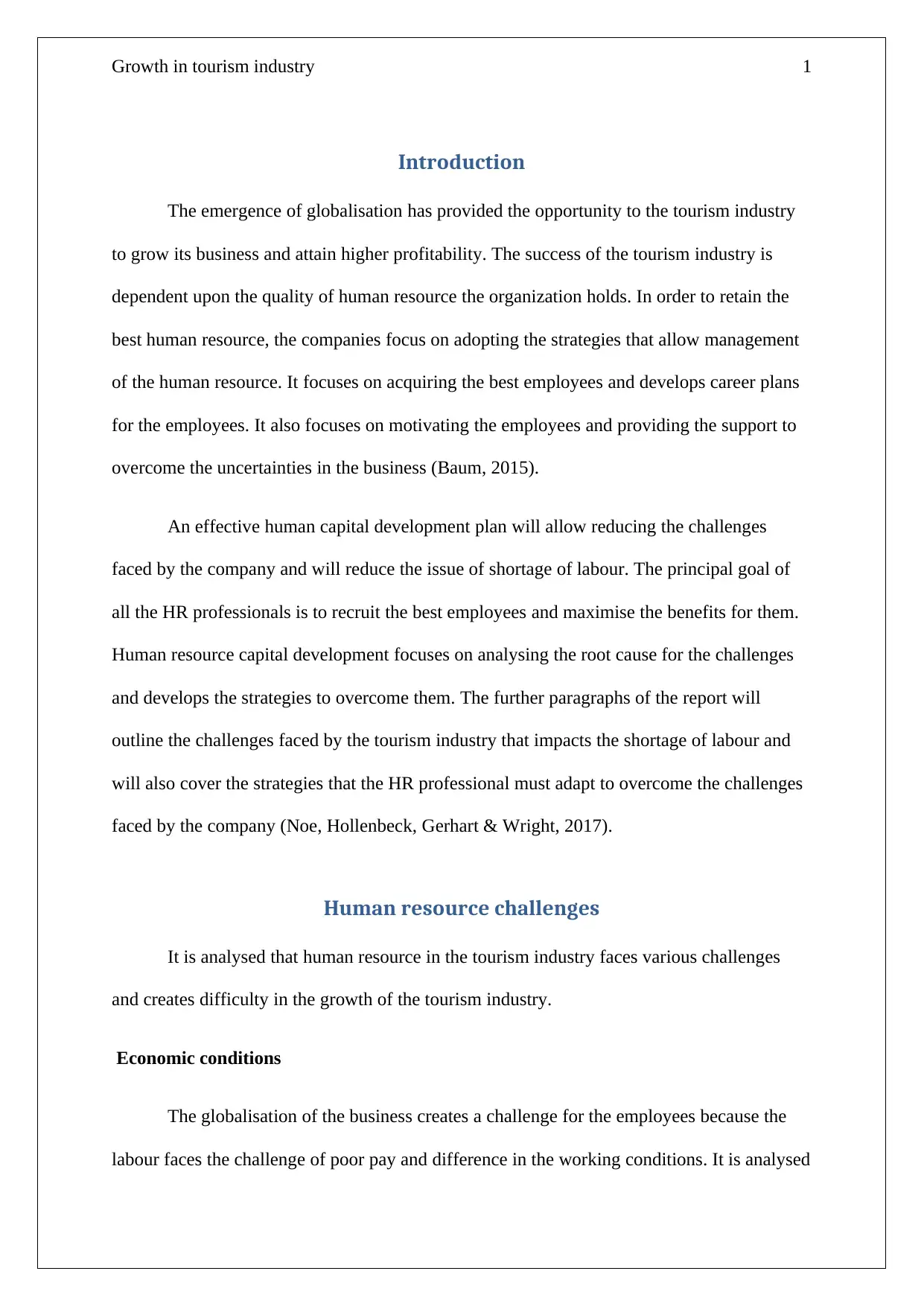
Growth in tourism industry 1
Introduction
The emergence of globalisation has provided the opportunity to the tourism industry
to grow its business and attain higher profitability. The success of the tourism industry is
dependent upon the quality of human resource the organization holds. In order to retain the
best human resource, the companies focus on adopting the strategies that allow management
of the human resource. It focuses on acquiring the best employees and develops career plans
for the employees. It also focuses on motivating the employees and providing the support to
overcome the uncertainties in the business (Baum, 2015).
An effective human capital development plan will allow reducing the challenges
faced by the company and will reduce the issue of shortage of labour. The principal goal of
all the HR professionals is to recruit the best employees and maximise the benefits for them.
Human resource capital development focuses on analysing the root cause for the challenges
and develops the strategies to overcome them. The further paragraphs of the report will
outline the challenges faced by the tourism industry that impacts the shortage of labour and
will also cover the strategies that the HR professional must adapt to overcome the challenges
faced by the company (Noe, Hollenbeck, Gerhart & Wright, 2017).
Human resource challenges
It is analysed that human resource in the tourism industry faces various challenges
and creates difficulty in the growth of the tourism industry.
Economic conditions
The globalisation of the business creates a challenge for the employees because the
labour faces the challenge of poor pay and difference in the working conditions. It is analysed
Introduction
The emergence of globalisation has provided the opportunity to the tourism industry
to grow its business and attain higher profitability. The success of the tourism industry is
dependent upon the quality of human resource the organization holds. In order to retain the
best human resource, the companies focus on adopting the strategies that allow management
of the human resource. It focuses on acquiring the best employees and develops career plans
for the employees. It also focuses on motivating the employees and providing the support to
overcome the uncertainties in the business (Baum, 2015).
An effective human capital development plan will allow reducing the challenges
faced by the company and will reduce the issue of shortage of labour. The principal goal of
all the HR professionals is to recruit the best employees and maximise the benefits for them.
Human resource capital development focuses on analysing the root cause for the challenges
and develops the strategies to overcome them. The further paragraphs of the report will
outline the challenges faced by the tourism industry that impacts the shortage of labour and
will also cover the strategies that the HR professional must adapt to overcome the challenges
faced by the company (Noe, Hollenbeck, Gerhart & Wright, 2017).
Human resource challenges
It is analysed that human resource in the tourism industry faces various challenges
and creates difficulty in the growth of the tourism industry.
Economic conditions
The globalisation of the business creates a challenge for the employees because the
labour faces the challenge of poor pay and difference in the working conditions. It is analysed
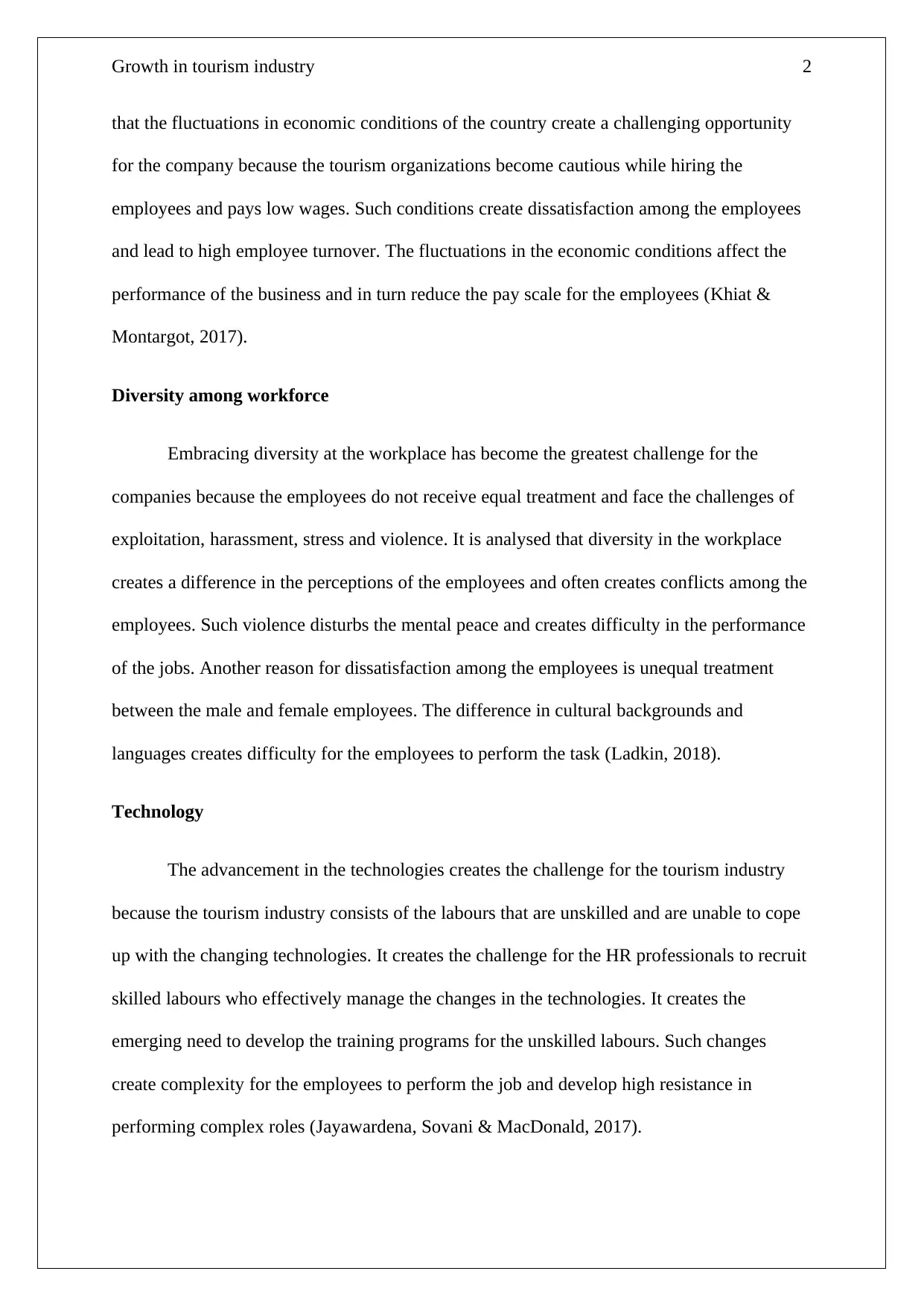
Growth in tourism industry 2
that the fluctuations in economic conditions of the country create a challenging opportunity
for the company because the tourism organizations become cautious while hiring the
employees and pays low wages. Such conditions create dissatisfaction among the employees
and lead to high employee turnover. The fluctuations in the economic conditions affect the
performance of the business and in turn reduce the pay scale for the employees (Khiat &
Montargot, 2017).
Diversity among workforce
Embracing diversity at the workplace has become the greatest challenge for the
companies because the employees do not receive equal treatment and face the challenges of
exploitation, harassment, stress and violence. It is analysed that diversity in the workplace
creates a difference in the perceptions of the employees and often creates conflicts among the
employees. Such violence disturbs the mental peace and creates difficulty in the performance
of the jobs. Another reason for dissatisfaction among the employees is unequal treatment
between the male and female employees. The difference in cultural backgrounds and
languages creates difficulty for the employees to perform the task (Ladkin, 2018).
Technology
The advancement in the technologies creates the challenge for the tourism industry
because the tourism industry consists of the labours that are unskilled and are unable to cope
up with the changing technologies. It creates the challenge for the HR professionals to recruit
skilled labours who effectively manage the changes in the technologies. It creates the
emerging need to develop the training programs for the unskilled labours. Such changes
create complexity for the employees to perform the job and develop high resistance in
performing complex roles (Jayawardena, Sovani & MacDonald, 2017).
that the fluctuations in economic conditions of the country create a challenging opportunity
for the company because the tourism organizations become cautious while hiring the
employees and pays low wages. Such conditions create dissatisfaction among the employees
and lead to high employee turnover. The fluctuations in the economic conditions affect the
performance of the business and in turn reduce the pay scale for the employees (Khiat &
Montargot, 2017).
Diversity among workforce
Embracing diversity at the workplace has become the greatest challenge for the
companies because the employees do not receive equal treatment and face the challenges of
exploitation, harassment, stress and violence. It is analysed that diversity in the workplace
creates a difference in the perceptions of the employees and often creates conflicts among the
employees. Such violence disturbs the mental peace and creates difficulty in the performance
of the jobs. Another reason for dissatisfaction among the employees is unequal treatment
between the male and female employees. The difference in cultural backgrounds and
languages creates difficulty for the employees to perform the task (Ladkin, 2018).
Technology
The advancement in the technologies creates the challenge for the tourism industry
because the tourism industry consists of the labours that are unskilled and are unable to cope
up with the changing technologies. It creates the challenge for the HR professionals to recruit
skilled labours who effectively manage the changes in the technologies. It creates the
emerging need to develop the training programs for the unskilled labours. Such changes
create complexity for the employees to perform the job and develop high resistance in
performing complex roles (Jayawardena, Sovani & MacDonald, 2017).
⊘ This is a preview!⊘
Do you want full access?
Subscribe today to unlock all pages.

Trusted by 1+ million students worldwide
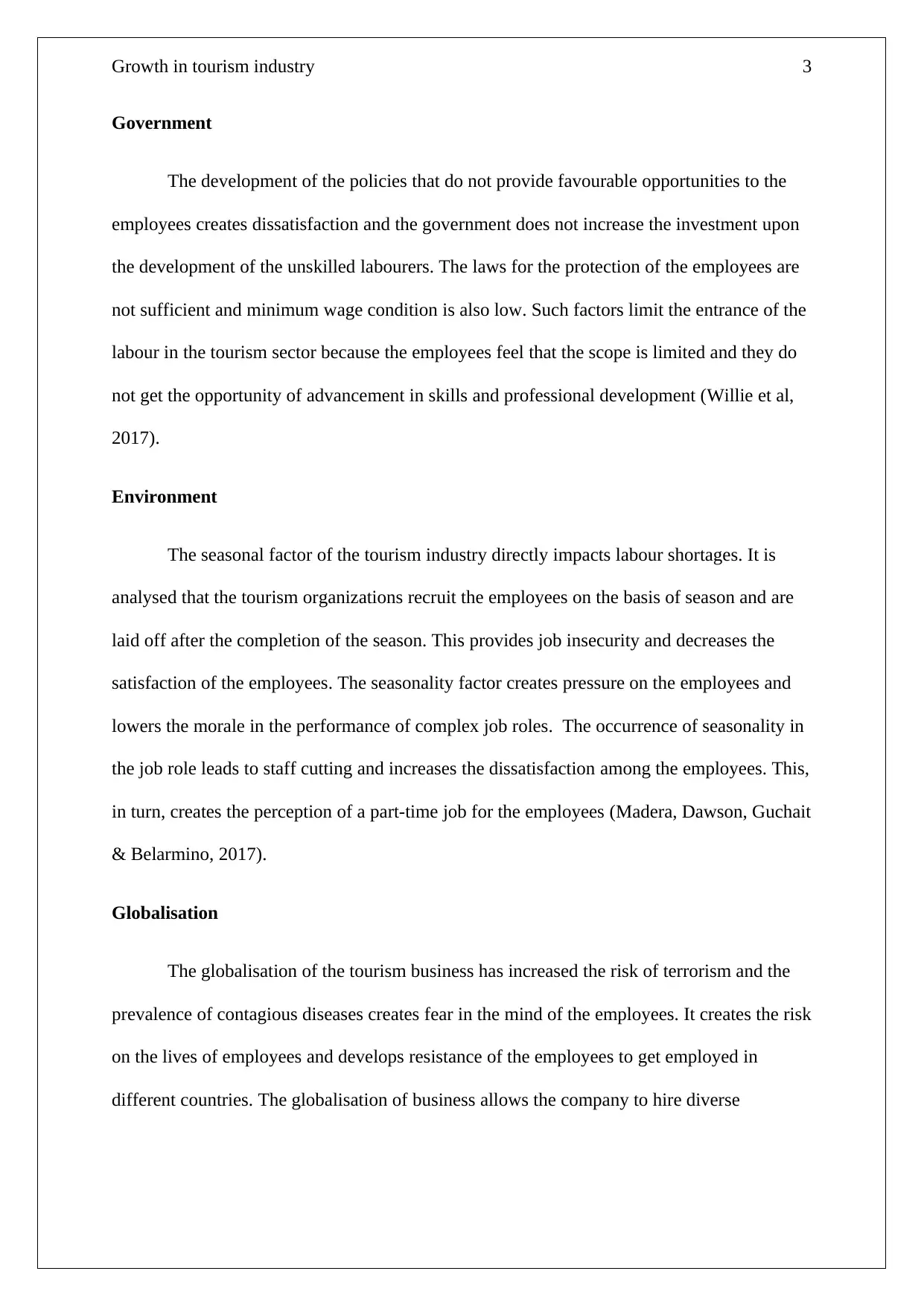
Growth in tourism industry 3
Government
The development of the policies that do not provide favourable opportunities to the
employees creates dissatisfaction and the government does not increase the investment upon
the development of the unskilled labourers. The laws for the protection of the employees are
not sufficient and minimum wage condition is also low. Such factors limit the entrance of the
labour in the tourism sector because the employees feel that the scope is limited and they do
not get the opportunity of advancement in skills and professional development (Willie et al,
2017).
Environment
The seasonal factor of the tourism industry directly impacts labour shortages. It is
analysed that the tourism organizations recruit the employees on the basis of season and are
laid off after the completion of the season. This provides job insecurity and decreases the
satisfaction of the employees. The seasonality factor creates pressure on the employees and
lowers the morale in the performance of complex job roles. The occurrence of seasonality in
the job role leads to staff cutting and increases the dissatisfaction among the employees. This,
in turn, creates the perception of a part-time job for the employees (Madera, Dawson, Guchait
& Belarmino, 2017).
Globalisation
The globalisation of the tourism business has increased the risk of terrorism and the
prevalence of contagious diseases creates fear in the mind of the employees. It creates the risk
on the lives of employees and develops resistance of the employees to get employed in
different countries. The globalisation of business allows the company to hire diverse
Government
The development of the policies that do not provide favourable opportunities to the
employees creates dissatisfaction and the government does not increase the investment upon
the development of the unskilled labourers. The laws for the protection of the employees are
not sufficient and minimum wage condition is also low. Such factors limit the entrance of the
labour in the tourism sector because the employees feel that the scope is limited and they do
not get the opportunity of advancement in skills and professional development (Willie et al,
2017).
Environment
The seasonal factor of the tourism industry directly impacts labour shortages. It is
analysed that the tourism organizations recruit the employees on the basis of season and are
laid off after the completion of the season. This provides job insecurity and decreases the
satisfaction of the employees. The seasonality factor creates pressure on the employees and
lowers the morale in the performance of complex job roles. The occurrence of seasonality in
the job role leads to staff cutting and increases the dissatisfaction among the employees. This,
in turn, creates the perception of a part-time job for the employees (Madera, Dawson, Guchait
& Belarmino, 2017).
Globalisation
The globalisation of the tourism business has increased the risk of terrorism and the
prevalence of contagious diseases creates fear in the mind of the employees. It creates the risk
on the lives of employees and develops resistance of the employees to get employed in
different countries. The globalisation of business allows the company to hire diverse
Paraphrase This Document
Need a fresh take? Get an instant paraphrase of this document with our AI Paraphraser
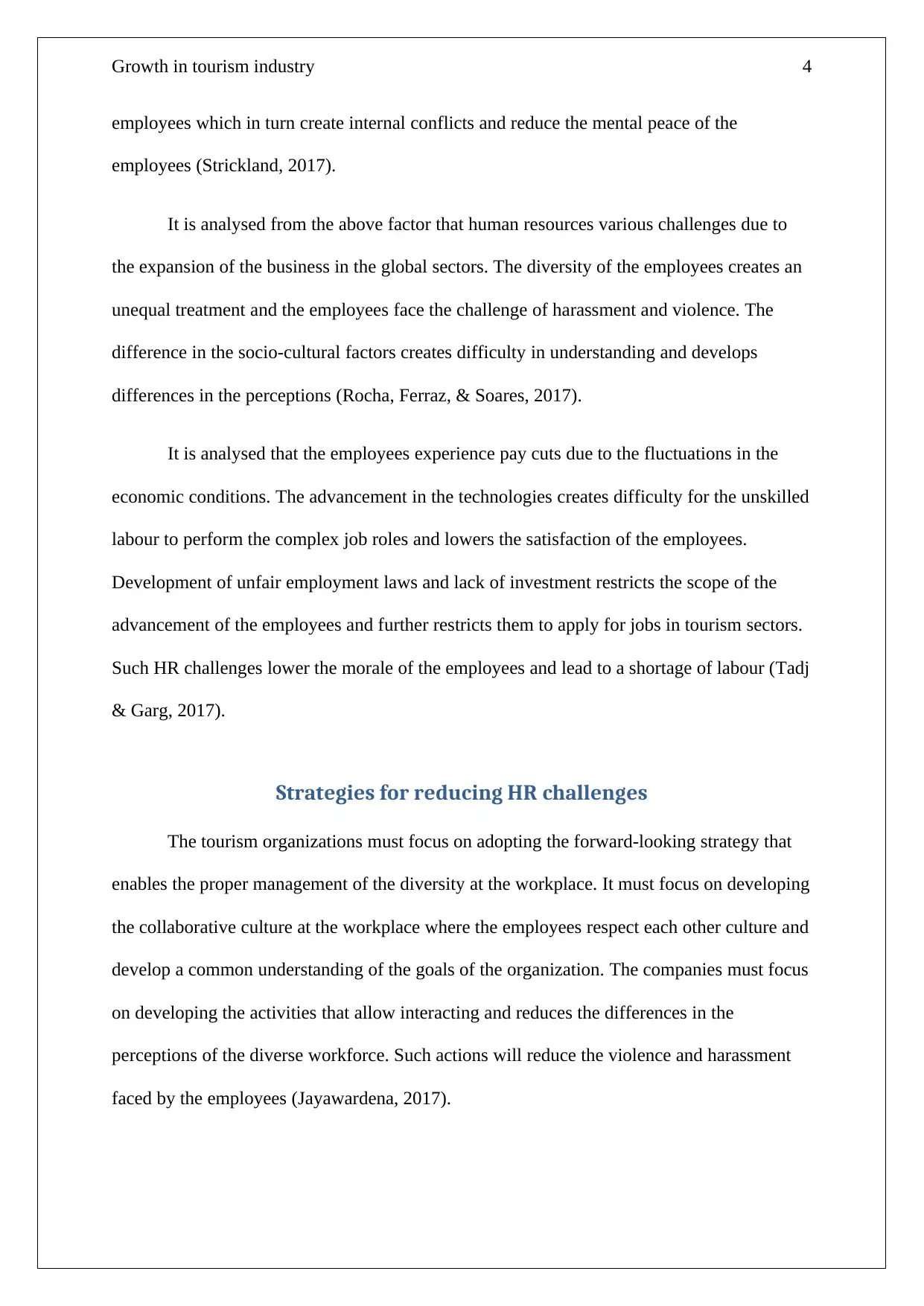
Growth in tourism industry 4
employees which in turn create internal conflicts and reduce the mental peace of the
employees (Strickland, 2017).
It is analysed from the above factor that human resources various challenges due to
the expansion of the business in the global sectors. The diversity of the employees creates an
unequal treatment and the employees face the challenge of harassment and violence. The
difference in the socio-cultural factors creates difficulty in understanding and develops
differences in the perceptions (Rocha, Ferraz, & Soares, 2017).
It is analysed that the employees experience pay cuts due to the fluctuations in the
economic conditions. The advancement in the technologies creates difficulty for the unskilled
labour to perform the complex job roles and lowers the satisfaction of the employees.
Development of unfair employment laws and lack of investment restricts the scope of the
advancement of the employees and further restricts them to apply for jobs in tourism sectors.
Such HR challenges lower the morale of the employees and lead to a shortage of labour (Tadj
& Garg, 2017).
Strategies for reducing HR challenges
The tourism organizations must focus on adopting the forward-looking strategy that
enables the proper management of the diversity at the workplace. It must focus on developing
the collaborative culture at the workplace where the employees respect each other culture and
develop a common understanding of the goals of the organization. The companies must focus
on developing the activities that allow interacting and reduces the differences in the
perceptions of the diverse workforce. Such actions will reduce the violence and harassment
faced by the employees (Jayawardena, 2017).
employees which in turn create internal conflicts and reduce the mental peace of the
employees (Strickland, 2017).
It is analysed from the above factor that human resources various challenges due to
the expansion of the business in the global sectors. The diversity of the employees creates an
unequal treatment and the employees face the challenge of harassment and violence. The
difference in the socio-cultural factors creates difficulty in understanding and develops
differences in the perceptions (Rocha, Ferraz, & Soares, 2017).
It is analysed that the employees experience pay cuts due to the fluctuations in the
economic conditions. The advancement in the technologies creates difficulty for the unskilled
labour to perform the complex job roles and lowers the satisfaction of the employees.
Development of unfair employment laws and lack of investment restricts the scope of the
advancement of the employees and further restricts them to apply for jobs in tourism sectors.
Such HR challenges lower the morale of the employees and lead to a shortage of labour (Tadj
& Garg, 2017).
Strategies for reducing HR challenges
The tourism organizations must focus on adopting the forward-looking strategy that
enables the proper management of the diversity at the workplace. It must focus on developing
the collaborative culture at the workplace where the employees respect each other culture and
develop a common understanding of the goals of the organization. The companies must focus
on developing the activities that allow interacting and reduces the differences in the
perceptions of the diverse workforce. Such actions will reduce the violence and harassment
faced by the employees (Jayawardena, 2017).
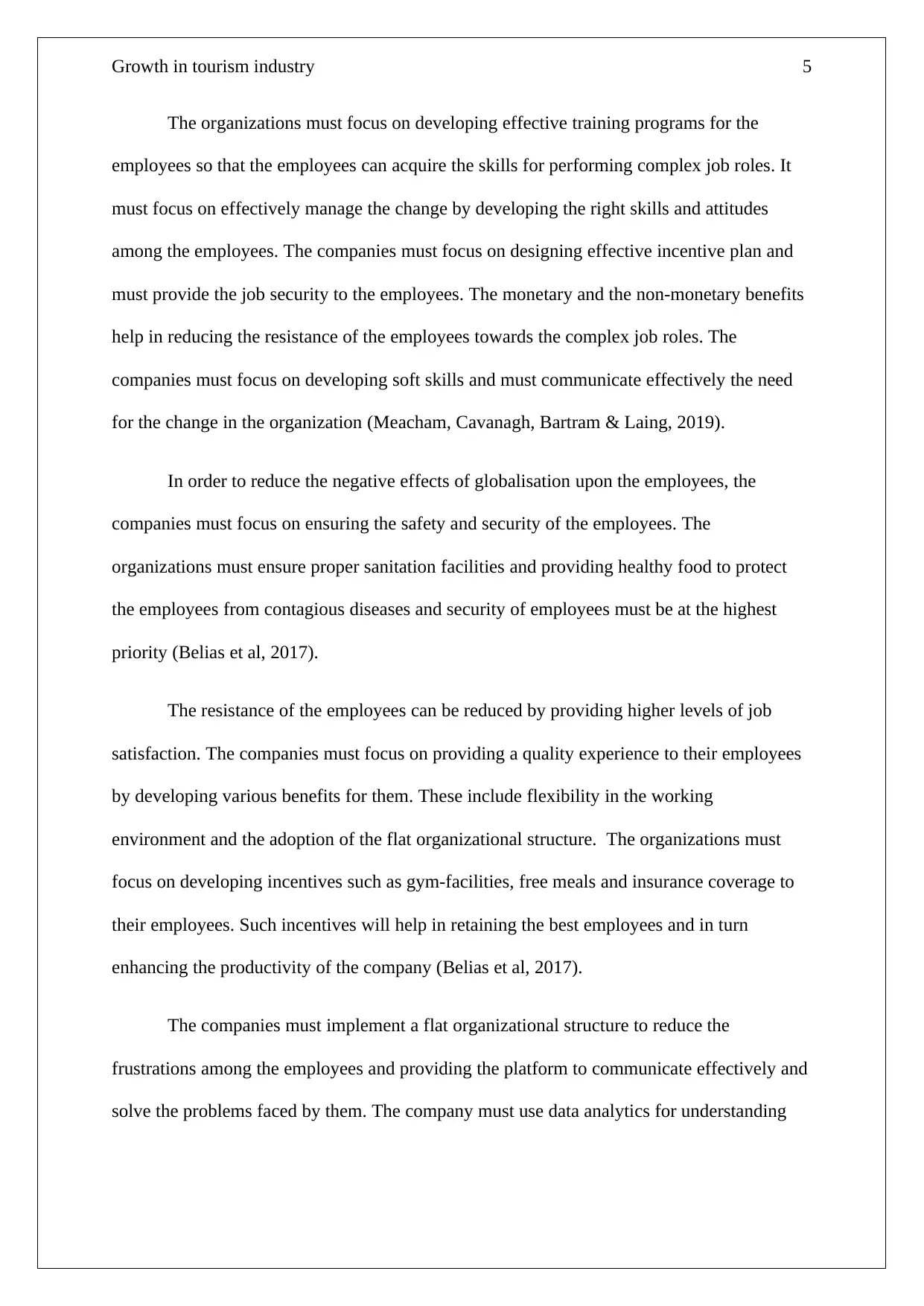
Growth in tourism industry 5
The organizations must focus on developing effective training programs for the
employees so that the employees can acquire the skills for performing complex job roles. It
must focus on effectively manage the change by developing the right skills and attitudes
among the employees. The companies must focus on designing effective incentive plan and
must provide the job security to the employees. The monetary and the non-monetary benefits
help in reducing the resistance of the employees towards the complex job roles. The
companies must focus on developing soft skills and must communicate effectively the need
for the change in the organization (Meacham, Cavanagh, Bartram & Laing, 2019).
In order to reduce the negative effects of globalisation upon the employees, the
companies must focus on ensuring the safety and security of the employees. The
organizations must ensure proper sanitation facilities and providing healthy food to protect
the employees from contagious diseases and security of employees must be at the highest
priority (Belias et al, 2017).
The resistance of the employees can be reduced by providing higher levels of job
satisfaction. The companies must focus on providing a quality experience to their employees
by developing various benefits for them. These include flexibility in the working
environment and the adoption of the flat organizational structure. The organizations must
focus on developing incentives such as gym-facilities, free meals and insurance coverage to
their employees. Such incentives will help in retaining the best employees and in turn
enhancing the productivity of the company (Belias et al, 2017).
The companies must implement a flat organizational structure to reduce the
frustrations among the employees and providing the platform to communicate effectively and
solve the problems faced by them. The company must use data analytics for understanding
The organizations must focus on developing effective training programs for the
employees so that the employees can acquire the skills for performing complex job roles. It
must focus on effectively manage the change by developing the right skills and attitudes
among the employees. The companies must focus on designing effective incentive plan and
must provide the job security to the employees. The monetary and the non-monetary benefits
help in reducing the resistance of the employees towards the complex job roles. The
companies must focus on developing soft skills and must communicate effectively the need
for the change in the organization (Meacham, Cavanagh, Bartram & Laing, 2019).
In order to reduce the negative effects of globalisation upon the employees, the
companies must focus on ensuring the safety and security of the employees. The
organizations must ensure proper sanitation facilities and providing healthy food to protect
the employees from contagious diseases and security of employees must be at the highest
priority (Belias et al, 2017).
The resistance of the employees can be reduced by providing higher levels of job
satisfaction. The companies must focus on providing a quality experience to their employees
by developing various benefits for them. These include flexibility in the working
environment and the adoption of the flat organizational structure. The organizations must
focus on developing incentives such as gym-facilities, free meals and insurance coverage to
their employees. Such incentives will help in retaining the best employees and in turn
enhancing the productivity of the company (Belias et al, 2017).
The companies must implement a flat organizational structure to reduce the
frustrations among the employees and providing the platform to communicate effectively and
solve the problems faced by them. The company must use data analytics for understanding
⊘ This is a preview!⊘
Do you want full access?
Subscribe today to unlock all pages.

Trusted by 1+ million students worldwide
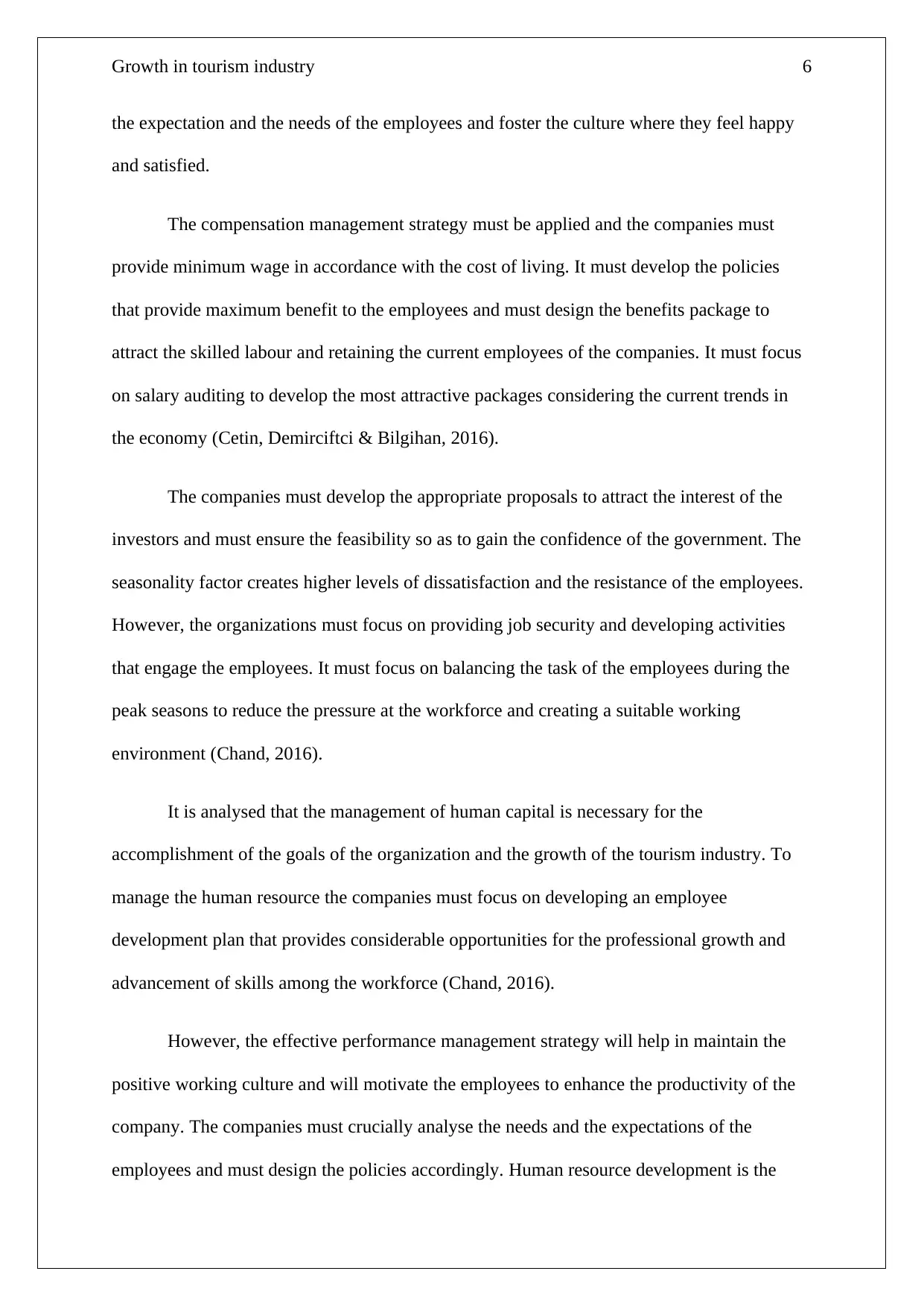
Growth in tourism industry 6
the expectation and the needs of the employees and foster the culture where they feel happy
and satisfied.
The compensation management strategy must be applied and the companies must
provide minimum wage in accordance with the cost of living. It must develop the policies
that provide maximum benefit to the employees and must design the benefits package to
attract the skilled labour and retaining the current employees of the companies. It must focus
on salary auditing to develop the most attractive packages considering the current trends in
the economy (Cetin, Demirciftci & Bilgihan, 2016).
The companies must develop the appropriate proposals to attract the interest of the
investors and must ensure the feasibility so as to gain the confidence of the government. The
seasonality factor creates higher levels of dissatisfaction and the resistance of the employees.
However, the organizations must focus on providing job security and developing activities
that engage the employees. It must focus on balancing the task of the employees during the
peak seasons to reduce the pressure at the workforce and creating a suitable working
environment (Chand, 2016).
It is analysed that the management of human capital is necessary for the
accomplishment of the goals of the organization and the growth of the tourism industry. To
manage the human resource the companies must focus on developing an employee
development plan that provides considerable opportunities for the professional growth and
advancement of skills among the workforce (Chand, 2016).
However, the effective performance management strategy will help in maintain the
positive working culture and will motivate the employees to enhance the productivity of the
company. The companies must crucially analyse the needs and the expectations of the
employees and must design the policies accordingly. Human resource development is the
the expectation and the needs of the employees and foster the culture where they feel happy
and satisfied.
The compensation management strategy must be applied and the companies must
provide minimum wage in accordance with the cost of living. It must develop the policies
that provide maximum benefit to the employees and must design the benefits package to
attract the skilled labour and retaining the current employees of the companies. It must focus
on salary auditing to develop the most attractive packages considering the current trends in
the economy (Cetin, Demirciftci & Bilgihan, 2016).
The companies must develop the appropriate proposals to attract the interest of the
investors and must ensure the feasibility so as to gain the confidence of the government. The
seasonality factor creates higher levels of dissatisfaction and the resistance of the employees.
However, the organizations must focus on providing job security and developing activities
that engage the employees. It must focus on balancing the task of the employees during the
peak seasons to reduce the pressure at the workforce and creating a suitable working
environment (Chand, 2016).
It is analysed that the management of human capital is necessary for the
accomplishment of the goals of the organization and the growth of the tourism industry. To
manage the human resource the companies must focus on developing an employee
development plan that provides considerable opportunities for the professional growth and
advancement of skills among the workforce (Chand, 2016).
However, the effective performance management strategy will help in maintain the
positive working culture and will motivate the employees to enhance the productivity of the
company. The companies must crucially analyse the needs and the expectations of the
employees and must design the policies accordingly. Human resource development is the
Paraphrase This Document
Need a fresh take? Get an instant paraphrase of this document with our AI Paraphraser
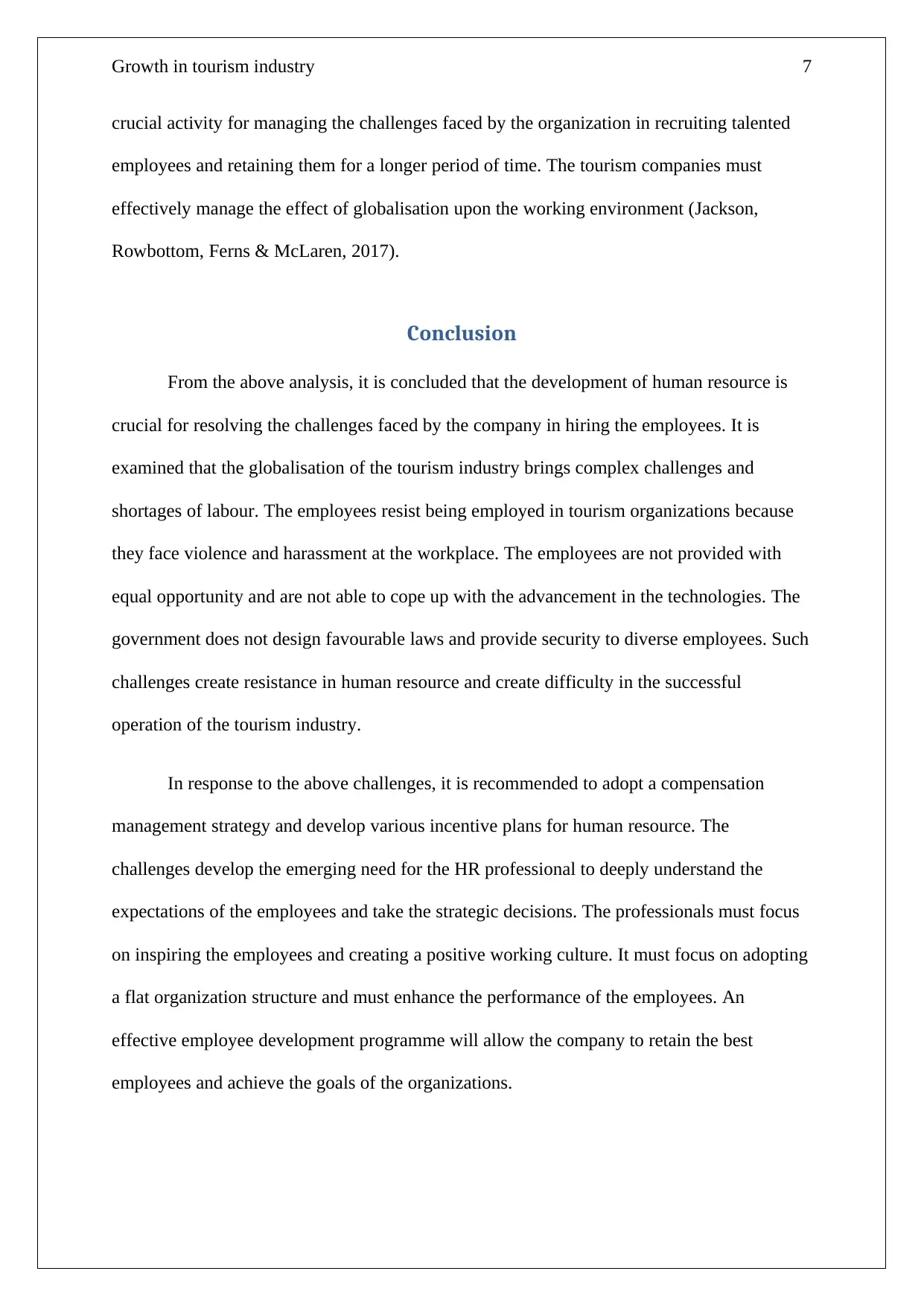
Growth in tourism industry 7
crucial activity for managing the challenges faced by the organization in recruiting talented
employees and retaining them for a longer period of time. The tourism companies must
effectively manage the effect of globalisation upon the working environment (Jackson,
Rowbottom, Ferns & McLaren, 2017).
Conclusion
From the above analysis, it is concluded that the development of human resource is
crucial for resolving the challenges faced by the company in hiring the employees. It is
examined that the globalisation of the tourism industry brings complex challenges and
shortages of labour. The employees resist being employed in tourism organizations because
they face violence and harassment at the workplace. The employees are not provided with
equal opportunity and are not able to cope up with the advancement in the technologies. The
government does not design favourable laws and provide security to diverse employees. Such
challenges create resistance in human resource and create difficulty in the successful
operation of the tourism industry.
In response to the above challenges, it is recommended to adopt a compensation
management strategy and develop various incentive plans for human resource. The
challenges develop the emerging need for the HR professional to deeply understand the
expectations of the employees and take the strategic decisions. The professionals must focus
on inspiring the employees and creating a positive working culture. It must focus on adopting
a flat organization structure and must enhance the performance of the employees. An
effective employee development programme will allow the company to retain the best
employees and achieve the goals of the organizations.
crucial activity for managing the challenges faced by the organization in recruiting talented
employees and retaining them for a longer period of time. The tourism companies must
effectively manage the effect of globalisation upon the working environment (Jackson,
Rowbottom, Ferns & McLaren, 2017).
Conclusion
From the above analysis, it is concluded that the development of human resource is
crucial for resolving the challenges faced by the company in hiring the employees. It is
examined that the globalisation of the tourism industry brings complex challenges and
shortages of labour. The employees resist being employed in tourism organizations because
they face violence and harassment at the workplace. The employees are not provided with
equal opportunity and are not able to cope up with the advancement in the technologies. The
government does not design favourable laws and provide security to diverse employees. Such
challenges create resistance in human resource and create difficulty in the successful
operation of the tourism industry.
In response to the above challenges, it is recommended to adopt a compensation
management strategy and develop various incentive plans for human resource. The
challenges develop the emerging need for the HR professional to deeply understand the
expectations of the employees and take the strategic decisions. The professionals must focus
on inspiring the employees and creating a positive working culture. It must focus on adopting
a flat organization structure and must enhance the performance of the employees. An
effective employee development programme will allow the company to retain the best
employees and achieve the goals of the organizations.
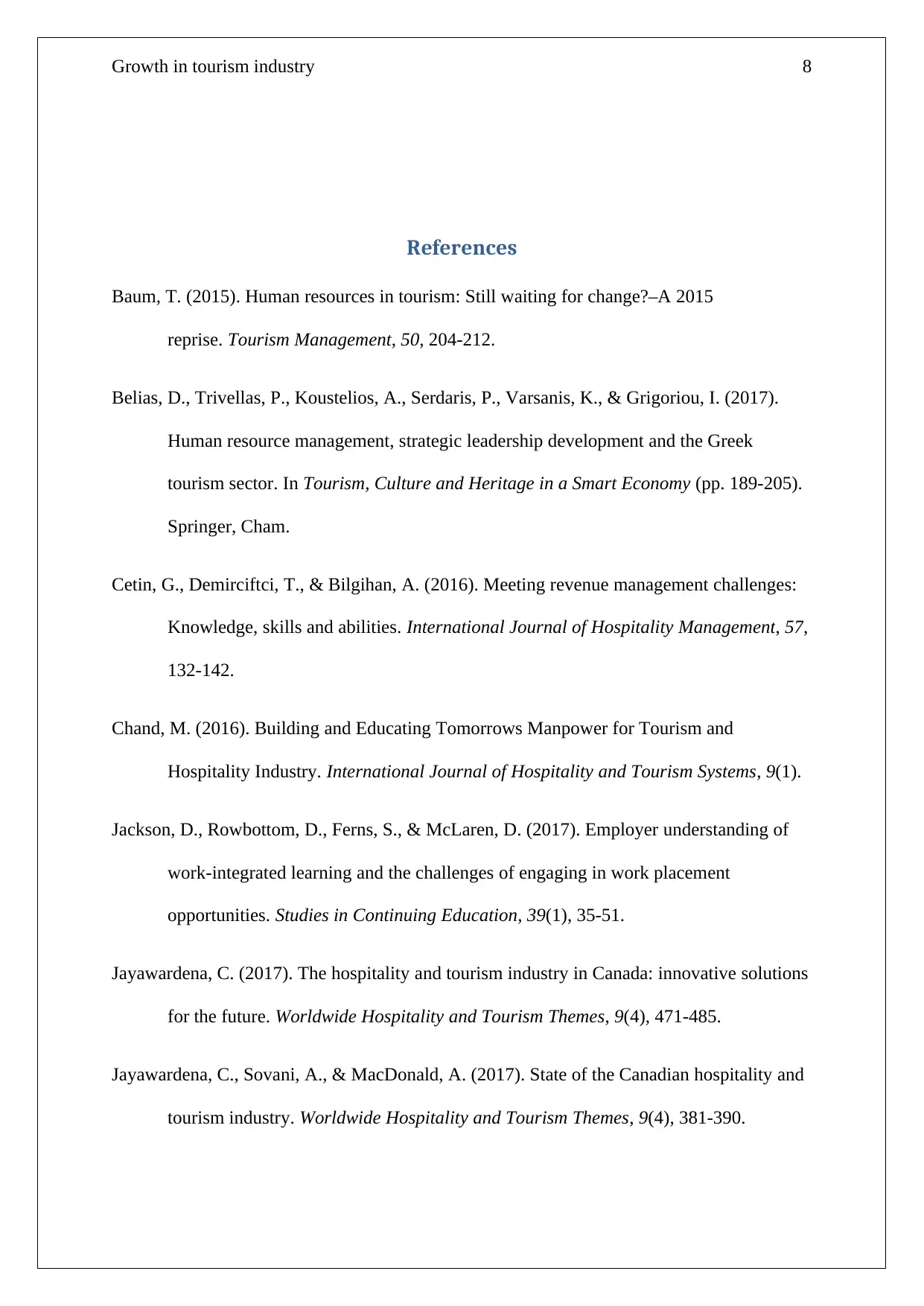
Growth in tourism industry 8
References
Baum, T. (2015). Human resources in tourism: Still waiting for change?–A 2015
reprise. Tourism Management, 50, 204-212.
Belias, D., Trivellas, P., Koustelios, A., Serdaris, P., Varsanis, K., & Grigoriou, I. (2017).
Human resource management, strategic leadership development and the Greek
tourism sector. In Tourism, Culture and Heritage in a Smart Economy (pp. 189-205).
Springer, Cham.
Cetin, G., Demirciftci, T., & Bilgihan, A. (2016). Meeting revenue management challenges:
Knowledge, skills and abilities. International Journal of Hospitality Management, 57,
132-142.
Chand, M. (2016). Building and Educating Tomorrows Manpower for Tourism and
Hospitality Industry. International Journal of Hospitality and Tourism Systems, 9(1).
Jackson, D., Rowbottom, D., Ferns, S., & McLaren, D. (2017). Employer understanding of
work-integrated learning and the challenges of engaging in work placement
opportunities. Studies in Continuing Education, 39(1), 35-51.
Jayawardena, C. (2017). The hospitality and tourism industry in Canada: innovative solutions
for the future. Worldwide Hospitality and Tourism Themes, 9(4), 471-485.
Jayawardena, C., Sovani, A., & MacDonald, A. (2017). State of the Canadian hospitality and
tourism industry. Worldwide Hospitality and Tourism Themes, 9(4), 381-390.
References
Baum, T. (2015). Human resources in tourism: Still waiting for change?–A 2015
reprise. Tourism Management, 50, 204-212.
Belias, D., Trivellas, P., Koustelios, A., Serdaris, P., Varsanis, K., & Grigoriou, I. (2017).
Human resource management, strategic leadership development and the Greek
tourism sector. In Tourism, Culture and Heritage in a Smart Economy (pp. 189-205).
Springer, Cham.
Cetin, G., Demirciftci, T., & Bilgihan, A. (2016). Meeting revenue management challenges:
Knowledge, skills and abilities. International Journal of Hospitality Management, 57,
132-142.
Chand, M. (2016). Building and Educating Tomorrows Manpower for Tourism and
Hospitality Industry. International Journal of Hospitality and Tourism Systems, 9(1).
Jackson, D., Rowbottom, D., Ferns, S., & McLaren, D. (2017). Employer understanding of
work-integrated learning and the challenges of engaging in work placement
opportunities. Studies in Continuing Education, 39(1), 35-51.
Jayawardena, C. (2017). The hospitality and tourism industry in Canada: innovative solutions
for the future. Worldwide Hospitality and Tourism Themes, 9(4), 471-485.
Jayawardena, C., Sovani, A., & MacDonald, A. (2017). State of the Canadian hospitality and
tourism industry. Worldwide Hospitality and Tourism Themes, 9(4), 381-390.
⊘ This is a preview!⊘
Do you want full access?
Subscribe today to unlock all pages.

Trusted by 1+ million students worldwide
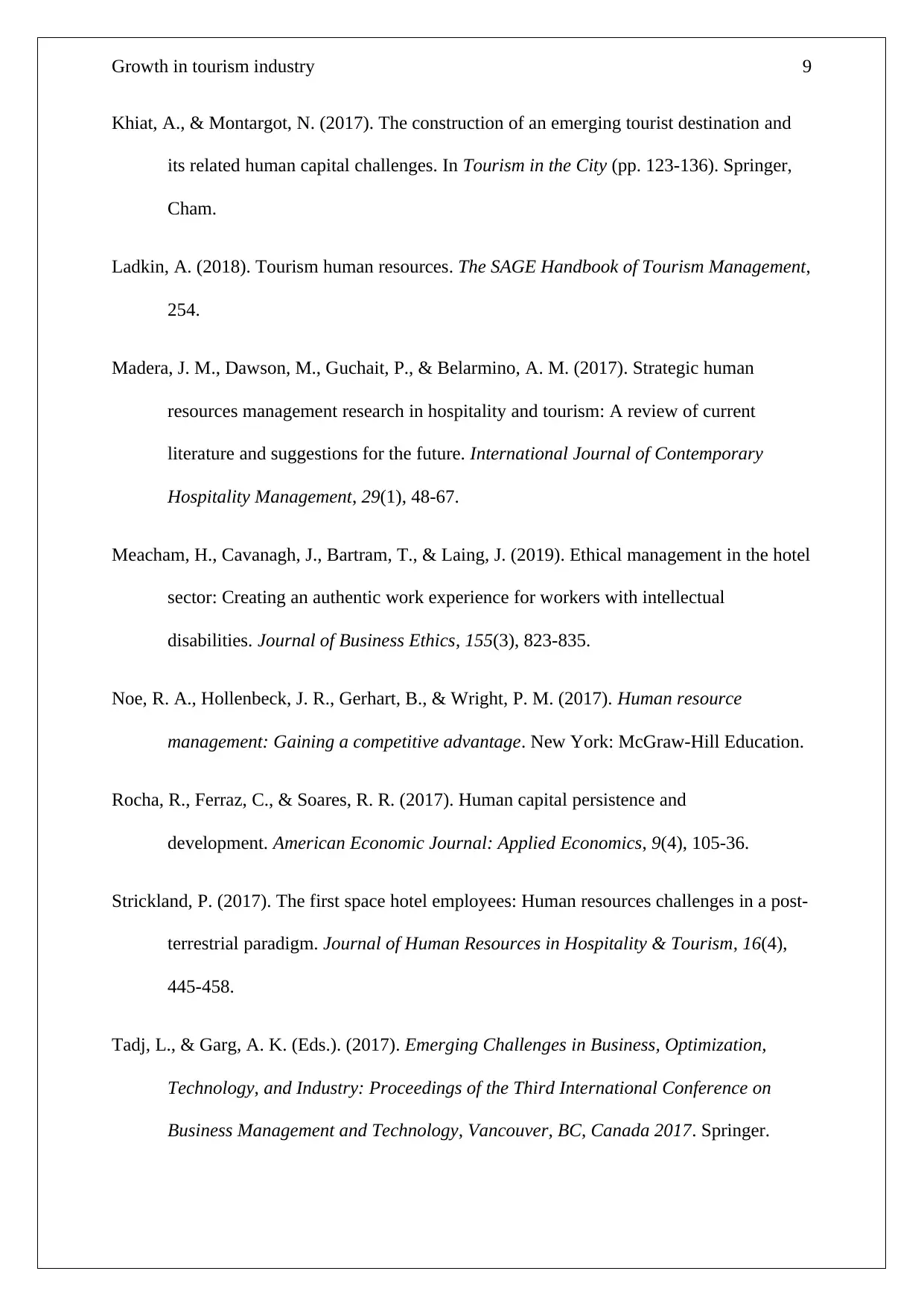
Growth in tourism industry 9
Khiat, A., & Montargot, N. (2017). The construction of an emerging tourist destination and
its related human capital challenges. In Tourism in the City (pp. 123-136). Springer,
Cham.
Ladkin, A. (2018). Tourism human resources. The SAGE Handbook of Tourism Management,
254.
Madera, J. M., Dawson, M., Guchait, P., & Belarmino, A. M. (2017). Strategic human
resources management research in hospitality and tourism: A review of current
literature and suggestions for the future. International Journal of Contemporary
Hospitality Management, 29(1), 48-67.
Meacham, H., Cavanagh, J., Bartram, T., & Laing, J. (2019). Ethical management in the hotel
sector: Creating an authentic work experience for workers with intellectual
disabilities. Journal of Business Ethics, 155(3), 823-835.
Noe, R. A., Hollenbeck, J. R., Gerhart, B., & Wright, P. M. (2017). Human resource
management: Gaining a competitive advantage. New York: McGraw-Hill Education.
Rocha, R., Ferraz, C., & Soares, R. R. (2017). Human capital persistence and
development. American Economic Journal: Applied Economics, 9(4), 105-36.
Strickland, P. (2017). The first space hotel employees: Human resources challenges in a post-
terrestrial paradigm. Journal of Human Resources in Hospitality & Tourism, 16(4),
445-458.
Tadj, L., & Garg, A. K. (Eds.). (2017). Emerging Challenges in Business, Optimization,
Technology, and Industry: Proceedings of the Third International Conference on
Business Management and Technology, Vancouver, BC, Canada 2017. Springer.
Khiat, A., & Montargot, N. (2017). The construction of an emerging tourist destination and
its related human capital challenges. In Tourism in the City (pp. 123-136). Springer,
Cham.
Ladkin, A. (2018). Tourism human resources. The SAGE Handbook of Tourism Management,
254.
Madera, J. M., Dawson, M., Guchait, P., & Belarmino, A. M. (2017). Strategic human
resources management research in hospitality and tourism: A review of current
literature and suggestions for the future. International Journal of Contemporary
Hospitality Management, 29(1), 48-67.
Meacham, H., Cavanagh, J., Bartram, T., & Laing, J. (2019). Ethical management in the hotel
sector: Creating an authentic work experience for workers with intellectual
disabilities. Journal of Business Ethics, 155(3), 823-835.
Noe, R. A., Hollenbeck, J. R., Gerhart, B., & Wright, P. M. (2017). Human resource
management: Gaining a competitive advantage. New York: McGraw-Hill Education.
Rocha, R., Ferraz, C., & Soares, R. R. (2017). Human capital persistence and
development. American Economic Journal: Applied Economics, 9(4), 105-36.
Strickland, P. (2017). The first space hotel employees: Human resources challenges in a post-
terrestrial paradigm. Journal of Human Resources in Hospitality & Tourism, 16(4),
445-458.
Tadj, L., & Garg, A. K. (Eds.). (2017). Emerging Challenges in Business, Optimization,
Technology, and Industry: Proceedings of the Third International Conference on
Business Management and Technology, Vancouver, BC, Canada 2017. Springer.
Paraphrase This Document
Need a fresh take? Get an instant paraphrase of this document with our AI Paraphraser
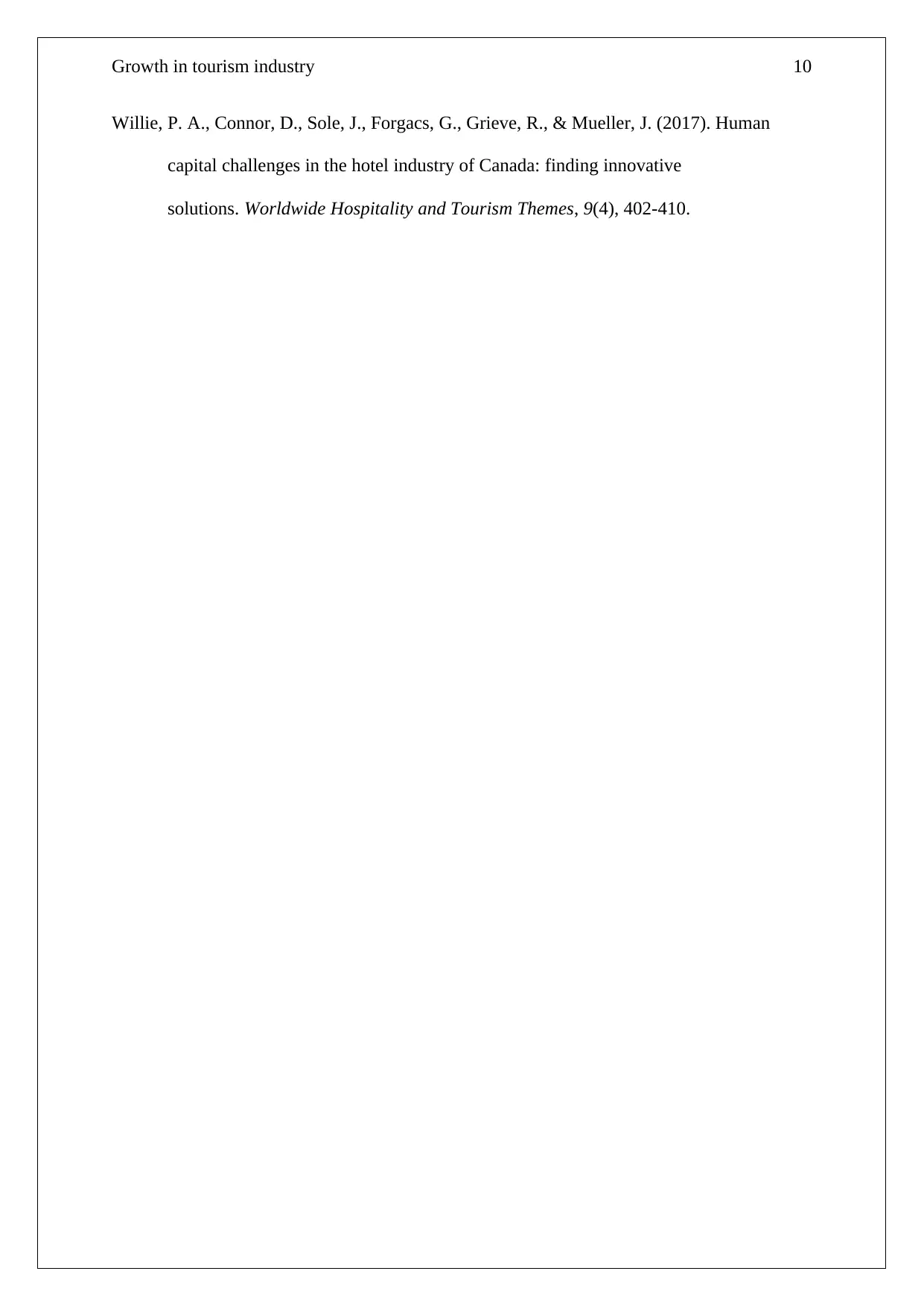
Growth in tourism industry 10
Willie, P. A., Connor, D., Sole, J., Forgacs, G., Grieve, R., & Mueller, J. (2017). Human
capital challenges in the hotel industry of Canada: finding innovative
solutions. Worldwide Hospitality and Tourism Themes, 9(4), 402-410.
Willie, P. A., Connor, D., Sole, J., Forgacs, G., Grieve, R., & Mueller, J. (2017). Human
capital challenges in the hotel industry of Canada: finding innovative
solutions. Worldwide Hospitality and Tourism Themes, 9(4), 402-410.
1 out of 11
Related Documents
Your All-in-One AI-Powered Toolkit for Academic Success.
+13062052269
info@desklib.com
Available 24*7 on WhatsApp / Email
![[object Object]](/_next/static/media/star-bottom.7253800d.svg)
Unlock your academic potential
Copyright © 2020–2025 A2Z Services. All Rights Reserved. Developed and managed by ZUCOL.





